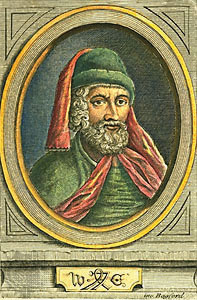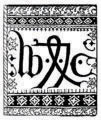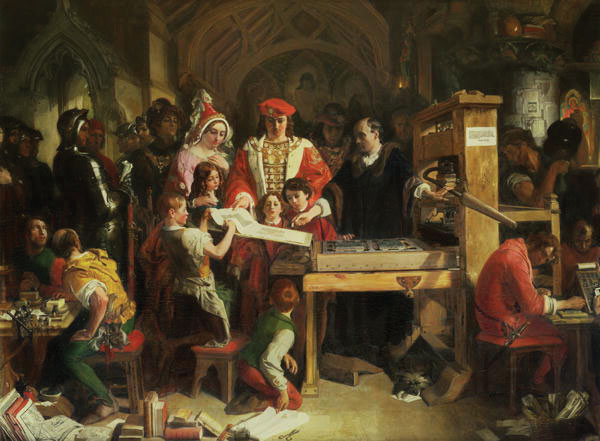This is “William Caxton and Printing in England”, section 1.2 from the book An Introduction to British Literature (v. 0.0). For details on it (including licensing), click here.
For more information on the source of this book, or why it is available for free, please see the project's home page. You can browse or download additional books there. To download a .zip file containing this book to use offline, simply click here.
1.2 William Caxton and Printing in England
PLEASE NOTE: This book is currently in draft form; material is not final.
Learning Objective
- Recognize the effects of William Caxton’s printing press on the development of the English language and British literature.

With the suppression of the Old English language at the time of the Norman Conquest and the replacement of English with French in official venues, English might have been lost forever. Instead, the English language survived and eventually flourished in the late Middle Ages. The future of the English language was further ensured with the arrival of William Caxton and the printing press in England. View a video mini-lecture on Caxton to learn about Caxton’s influence on the English language.

Caxton’s printing device.
The Printing Press
In 1476, Caxton set up a printing press in the vicinity of Westminster Abbey and began to print books, some in Latin as had been traditional, but Caxton also printed books in English. Because there was no standardization in English spelling, Caxton’s choices often became the standard.

Caxton showing the first specimen of his printing to King Edward IV at the Almonry, Westminster.
Daniel Maclise, 1851
The British Library has made available online a comparison of Caxton’s two printings of Chaucer’s Canterbury Tales, 1476 and 1483. In addition, Barbara Bordalejo in the Canterbury Tales Project at De Montfort University provides a digitized version of the British Library manuscripts that allows the reader to see the Middle English text side by side with the manuscript version and to search for specific lines and words. Britain’s National Archives contains the first document printed by Caxton.
KUHF radio station in Houston, Texas broadcasts “Engines of Our Ingenuity.” John H. Lienhard, Professor Emeritus of Mechanical Engineering and History at the University of Houston, wrote and narrates an audio of an episode on Caxton and the printing press. The website includes both the podcast and a written text.
Key Takeaway
- Caxton’s establishment of the printing press in England helped standardize the English language and promote the use of English in written texts.
Exercises
- The Folger Shakespeare Library provides a video demonstration of an early modern printing press. While watching the video, make a list of words used in early printing techniques that are still used, even with today’s computerized printing techniques.
- Caxton is credited with helping to promote the use of the English language. After reading the British Library’s section on Caxton’s Texts, including the section on Caxton’s English, write a brief paragraph explaining why Caxton chose to print works in the vernacular rather than in Latin.
Resources: William Caxton and Printing in England
Biography
- “Caxton’s Chaucer.” Treasures in Full. British Library. http://www.bl.uk/treasures/caxton/homepage.html
- “Caxton’s Life.” Treasures in Full: Caxton’s Chaucer. British Library. http://www.bl.uk/treasures/caxton/caxtonslife.html
- William Caxton (c.1422–1492). Historic Figures. BBC. http://www.bbc.co.uk/history/historic_figures/caxton_william.shtml
- “William Caxton.” History. Famous People and the Abbey. Westminster Abbey. http://www.westminster-abbey.org/our-history/people/william-caxton
Printing Press
- “Caxton’s English.” Treasures in Full: Caxton’s Chaucer. British Library. http://www.bl.uk/treasures/caxton/english.html
- “Caxton’s Technologies.” Treasures in Full: Caxton’s Chaucer. British Library. http://www.bl.uk/treasures/caxton/caxtonstechnologies.html
- “Caxton’s Texts.” Treasures in Full: Caxton’s Chaucer. British Library. http://www.bl.uk/treasures/caxton/caxtonstexts.html
- “The First Page Printed in England.” Treasures. National Archives. http://www.nationalarchives.gov.uk/museum/item.asp?item_id=9
- “William Caxton.” John H. Leinhard. Engines of Our Ingenuity. University of Houston's College of Engineering. podcast and text. http://www.uh.edu/engines/epi785.htm
Caxton’s Chaucer
- Caxton's Canterbury Tales: The British Library Copies. Barbara Bordalejo. Canterbury Tales Project. De Montfort University. http://www.cts.dmu.ac.uk/Caxtons/
- “Caxton’s Chaucer.” Treasures in Full. British Library. http://www.bl.uk/treasures/caxton/homepage.html
Video
- “Printing 101.” Steven Galbraith, Andrew W. Mellon Curator of Books. Folger Shakespeare Library. http://youtu.be/lX6e8Q2nc5A
- William Caxton and the Printing Press. Dr. Carol Lowe. McLennan Community College. http://www.youtube.com/user/DrLoweMCC#p/u/18/1lMn5OGJrPU




